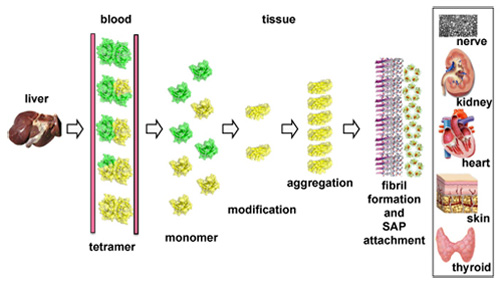- HOME
- Research Content
- Zhenghua Li
Research Content
Zhenghua Li
FAP group
Familial amyloid polyneuropathy (FAP) is an autosomal dominant genetic disease whose main symptoms are peripheral and autonomic neuropathy. The average age of onset is between the 30s and 40s, and once developed is progressive and eventually fatal with death to occur 10 to 20 years later. FAP is caused by point mutations in the transthyretin (TTR) gene, and mutant protein as amyloids are deposited in a variety of organs including peripheral nerves, the heart, and the kidney. The human TTR gene is a gene of about 7kb, with four exons and three introns. It is expressed mainly in the liver, the choroid plexus of the brain, and the retina, and is secreted respectively in the blood, cerebrospinal fluid, and the corpus vitreum. It consists of four identical subunits to form a tetramer of 55 kDa, and in the blood acts as a carrier of thyroxine and retinol-binding protein. So far, more than 110 amino acid mutations have been found, and of these, 90 mutations have been associated with amyloidosis. The steps of amyloid deposition are summarized below (see chart).
(1) Expression of TTR in the liver, (2) Formation of TTR tetramer and secretion into the bloodstream, (3) Dissociation into monomers, (4) Modification of the monomers, (5) Aggregation of monomers, (6) Deposition of amyloid fibrils and adhesion of blood serum amyloid P component.
For the purpose of analyzing the pathogenesis and condition of TTR-related amyloidosis, a large number of transgenic/knockout mice/knock-in mice have been produced. Using these have revealed the following:
(1) The upstream 6kb human TTR gene includes the cis-element necessary for tissue-specific and stage-specific expression; (2) the human TTR level in blood reaches mature levels at 4 weeks after birth, but amyloid deposition occurs at 6 months or later; (3) amyloid deposition in the SPF environment has not been observed and environmental factors are involved in its occurrence (6); (4) the 10th Cys is involved in conformational change and is essential for amyloid deposition; (5) the blood serum amyloid P component does not act as a trigger for amyloid deposition; (6) mouse TTR molecules are involved in the stabilization of humanized mouse tetramers (5); and (7) the human TTR homotetramer has a low affinity with mouse RBP4 (5).
From the above facts, preparation of both Ttr and Rbp loci in humanized-mouse models is thought to be important in the development of pathological analysis and new treatments of FAP. Therefore, a targeting vector including lox71 and lox66 was first introduced to both ends of the neomycin resistant gene, and a mouse in which the Ttr gene had been completely destroyed was produced. Then, due to the replacement vector that contains the lox66-human TTR cDNA-loxP and the Cre expression vector, site-specific recombination was performed and a mouse Ttr locus normal human TTR cDNA (Val 30) and mutant human TTR cDNA (Met 30) humanized mouse was produced. In this mouse, TTR cDNA was expressed in almost the same pattern both quantitatively and qualitatively as the mouse TTR cDNA (5). Furthermore, a Rbp locus humanized-mouse was created and was mated to produce a double-humanized mouse with Ttr and Rbp4 loci. Currently, a medication for preventing amyloid deposition is being investigated through using humanized mice in collaboration with pharmaceutical companies.












